Chapter 5 - Heat - Thermal Expansion Exercise 202
Question 1
Define the following terms:
(i) Coefficient of linear expansion
(ii) Coefficient of superficial expansion
(iii) Coefficient of cubical expansion
(i) Coefficient of linear expansion
(ii) Coefficient of superficial expansion
(iii) Coefficient of cubical expansion
Solution 1
(i). Coefficient of Linear expansion is equal to the change in length of a rod of length 1m when its temperature rises by 10c.
(ii).Coefficient of superficial expansion is equal to the change in area of a rod of area 1m2 when its temperature rises by 10c.
(iii).Coefficient of volume expansion is equal to the change in volume of a rod of volume 1m3 when its temperature rises by 10c.
(ii).Coefficient of superficial expansion is equal to the change in area of a rod of area 1m2 when its temperature rises by 10c.
(iii).Coefficient of volume expansion is equal to the change in volume of a rod of volume 1m3 when its temperature rises by 10c.
Question 2
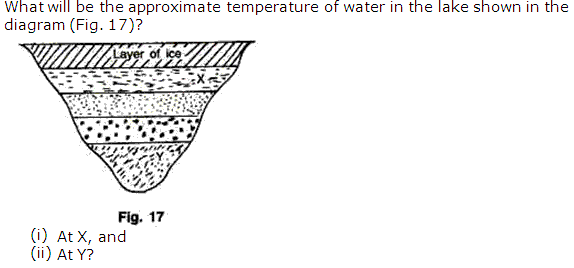
Solution 2
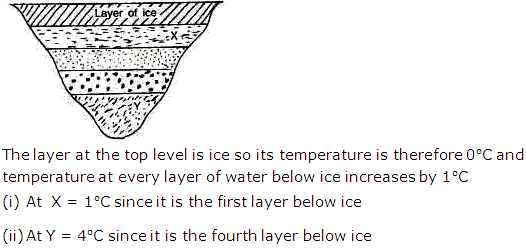
Question 3
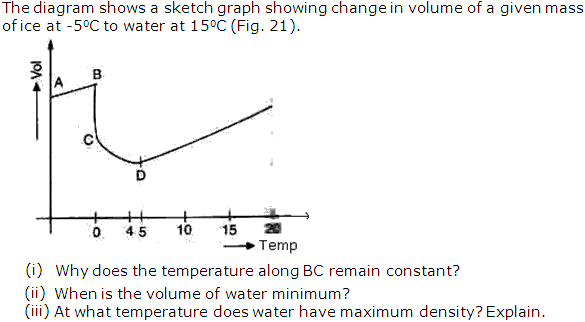
Solution 3
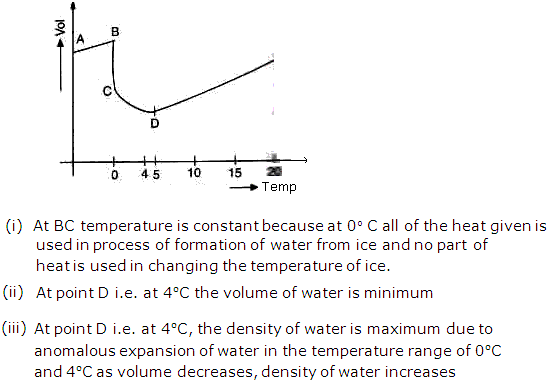
Question 4
State the relation between the three types of expansion.
Solution 4
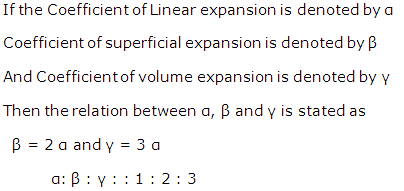
Question 5
What is a bimetallic strip? What is the criterion of choosing the two metals for a bimetal strip? Give two uses of a bimetal strip.
Solution 5
A bimetallic strip consists of two metal strips- one with high coefficient of expansion and the other with low coefficient of expansion. Two different metals are used for regulating temperature in an electrical device as the strip bends due to different coefficient of expansion on excessive heating due to current, thus breaking electrical circuit until the strip cools down to a preset point. Two applications of bimetallic strip are thermostat in electric iron and in balance wheels.
(a). When boiling water is poured into a glass bottle, it generally cracks because on pouring hot water in the bottle the inner surface heats up and expands more as compared to its outer surface. This unequal expansion between the two surfaces causes a strain and the bottle cracks.
(b). Telephone wires sag in summer because due to heat of the sun, the wire expands and increases in length, thus they sag in summer.
(c). In cold countries water pipes burst in winter because the water has maximum density at 40C and, due to anomalous expansion of water, it expands when the water is cooled to a temperature below 40C
(d). Even when the water in the lakes is frozen, fishes can survive due to anomalous expansion of water, water has maximum density at 40C and this dense water remains at the bottom of the lake and the upper layer of water is less dense and freezes but the temperature of each layer of water below increases by 10C. Thus it is warmer in the lakes below the ice layer. This helps the fishes to survive.
(a). When boiling water is poured into a glass bottle, it generally cracks because on pouring hot water in the bottle the inner surface heats up and expands more as compared to its outer surface. This unequal expansion between the two surfaces causes a strain and the bottle cracks.
(b). Telephone wires sag in summer because due to heat of the sun, the wire expands and increases in length, thus they sag in summer.
(c). In cold countries water pipes burst in winter because the water has maximum density at 40C and, due to anomalous expansion of water, it expands when the water is cooled to a temperature below 40C
(d). Even when the water in the lakes is frozen, fishes can survive due to anomalous expansion of water, water has maximum density at 40C and this dense water remains at the bottom of the lake and the upper layer of water is less dense and freezes but the temperature of each layer of water below increases by 10C. Thus it is warmer in the lakes below the ice layer. This helps the fishes to survive.
Question 6

Solution 6

Question 7
What is a thermostat? Give two uses of thermostat.
Solution 7
Thermostat is a device for regulating temperature in electric circuits and it is made up of bimetallic strip. Two applications of thermostat are in electric iron and in refrigerators.
Question 8
Explain the 'anomalous expansion' of water.
Solution 8
When heated, water expands normally but behavior of water is unusual over a small range of temperature between 0 and 40C. This is known as anomalous expansion of water.
Question 9
What properties of water slow down the complete freezing of the water in the lake?
Solution 9
Anomalous expansion of water slows down the complete freezing of water in the lake.
Question 10
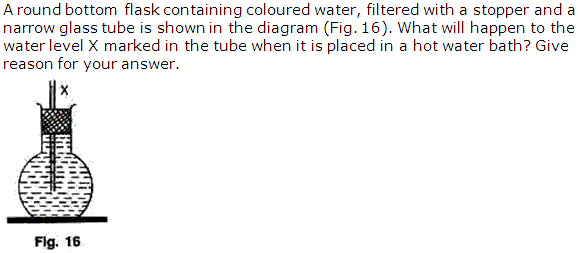
Solution 10
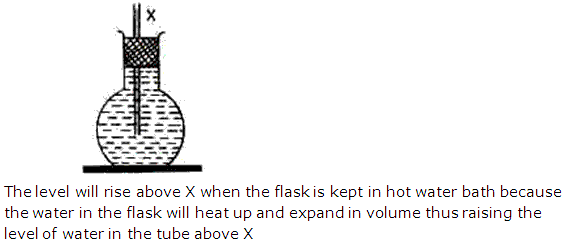
Question 11
Give reasons for the following:
(i) When boiling water is poured into a glass bottle, it generally cracks.
(ii) Telephone wires sag in summer.
(iii) In cold countries water pipes burst in winter.
(iv) Even when the water in the lakes is frozen, fish can survive.
(i) When boiling water is poured into a glass bottle, it generally cracks.
(ii) Telephone wires sag in summer.
(iii) In cold countries water pipes burst in winter.
(iv) Even when the water in the lakes is frozen, fish can survive.
Solution 11
(i). When boiling water is poured into a glass bottle, it generally cracks because on pouring hot water in the bottle the inner surface heats up and expands more as compared to its outer surface. This unequal expansion between the two surfaces causes a strain and the bottle cracks.
(ii). Telephone wires sag in summer because due to heat of the sun, the wire expands and increases in length, thus they sag in summer.
(iii).In cold countries water pipes burst in winter because the water has maximum density at 40C and, due to anomalous expansion of water, it expands when the water is cooled to a temperature below 40C
(iv).Even when the water in the lakes is frozen, fishes can survive due to anomalous expansion of water, water has maximum density at 4(i). When boiling water is poured into a glass bottle, it generally cracks because on pouring hot water in the bottle the inner surface heats up and expands more as compared to its outer surface. This unequal expansion between the two surfaces causes a strain and the bottle cracks.
(ii). Telephone wires sag in summer because due to heat of the sun, the wire expands and increases in length, thus they sag in summer.
(iii).In cold countries water pipes burst in winter because the water has maximum density at 40C and, due to anomalous expansion of water, it expands when the water is cooled to a temperature below 40C
(iv).Even when the water in the lakes is frozen, fishes can survive due to anomalous expansion of water, water has maximum density at 40C and this dense water remains at the bottom of the lake and the upper layer of water is less dense and freezes but the temperature of each layer of water below increases by 10C. Thus it is warmer in the lakes below the ice layer. This helps the fishes to survive.C and this dense water remains at the bottom of the lake and the upper layer of water is less dense and freezes but the temperature of each layer of water below increases by 10C. Thus it is warmer in the lakes below the ice layer. This helps the fishes to survive.
(ii). Telephone wires sag in summer because due to heat of the sun, the wire expands and increases in length, thus they sag in summer.
(iii).In cold countries water pipes burst in winter because the water has maximum density at 40C and, due to anomalous expansion of water, it expands when the water is cooled to a temperature below 40C
(iv).Even when the water in the lakes is frozen, fishes can survive due to anomalous expansion of water, water has maximum density at 4(i). When boiling water is poured into a glass bottle, it generally cracks because on pouring hot water in the bottle the inner surface heats up and expands more as compared to its outer surface. This unequal expansion between the two surfaces causes a strain and the bottle cracks.
(ii). Telephone wires sag in summer because due to heat of the sun, the wire expands and increases in length, thus they sag in summer.
(iii).In cold countries water pipes burst in winter because the water has maximum density at 40C and, due to anomalous expansion of water, it expands when the water is cooled to a temperature below 40C
(iv).Even when the water in the lakes is frozen, fishes can survive due to anomalous expansion of water, water has maximum density at 40C and this dense water remains at the bottom of the lake and the upper layer of water is less dense and freezes but the temperature of each layer of water below increases by 10C. Thus it is warmer in the lakes below the ice layer. This helps the fishes to survive.C and this dense water remains at the bottom of the lake and the upper layer of water is less dense and freezes but the temperature of each layer of water below increases by 10C. Thus it is warmer in the lakes below the ice layer. This helps the fishes to survive.
Chapter 5 - Heat - Thermal Expansion Exercise 203
Question 1
Complete the following sentences:
(i) Density of water is -------------. At 40C.
(ii) When ice melts its volume -------------- and density --------------.
(iii) In a bimetal two metals of different -------------- of -------------- are used.
(iv) Water pipes burst in winter in very cold countries is due to --------------
(v) CGS units of heat is --------------.
(vi) SI unit of temperature is --------------.
(i) Density of water is -------------. At 40C.
(ii) When ice melts its volume -------------- and density --------------.
(iii) In a bimetal two metals of different -------------- of -------------- are used.
(iv) Water pipes burst in winter in very cold countries is due to --------------
(v) CGS units of heat is --------------.
(vi) SI unit of temperature is --------------.
Solution 1
(i). Maximum
(ii). Increases; decreases
(iii). Coefficient; expansion
(iv). Anomalous expansion of water
(v). Calorie
(iv). Kelvin(K)
(ii). Increases; decreases
(iii). Coefficient; expansion
(iv). Anomalous expansion of water
(v). Calorie
(iv). Kelvin(K)
Question 2
A glass stopper has got stuck in the neck of a bottle. How can you remove the stopper without breaking the bottle?
Solution 2
We should heat the neck of the bottle because due to heating the neck will expand and loosen the stopper stuck in the neck. In this way, we can easily remove the stopper.
Question 3
What is meant by apparent expansion and real expansion of a liquid?
Solution 3
When a liquid is heated in a flask. Due to heat, the flask expands along with the liquid, thus providing more space for the liquid. Hence the level of the liquid falls. Thus this dropped level shows the apparent expansion of the liquid. The actual expansion of the liquid, when heated, is the real expansion.
Question 4
Equal volumes of alcohol and mercury are heated uniformly in identical containers separately from 100C to 500C. Will both the liquids occupy the same volume? Give reason.
Solution 4
No, the both liquids i.e. mercury and alcohol will not have same volume on heating as they have different coefficient of expansions, thus they expand differently on heating at same temperature range. Alcohol expands more than mercury.
Question 5
How will you demonstrate thermal expansion in liquids? Describe an experiment.
Solution 5
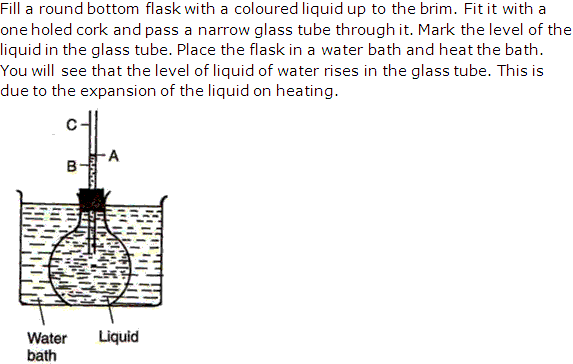
Question 6
Describe an experiment to demonstrate thermal expansion in gases.
Solution 6
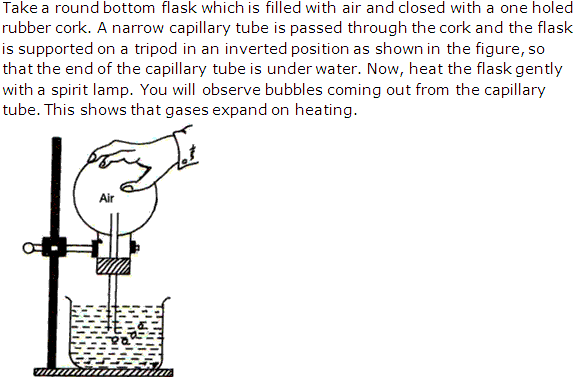
Question 7
Why does a hot glass chimney often crack when a drop of water falls on it?
Solution 7
A hot glass chimney often crack when a drop of water falls on it because the glass of the chimney expands due to constant heating by the flame of the chimney but as a cooler water drop falls on the glass, the outer surface contracts more than the inner side of the glass. . This unequal contraction between the two surfaces causes a strain and the glass cracks.
Question 8
Can we fuse an iron wire in a glass rod? Give reason to your answer.
Solution 8
No, we cannot fuse iron wire in glass rod because glass is bad conductor of heat and it does not allow heat to pass through it and iron wire would not be able to get sufficient heat to fuse.
Question 9
Suggest some suitable way to remove a tight glass stopper from a bottle.
Solution 9
We should heat the neck of the bottle because due to heating the neck will expand and loosen the stopper stuck in the neck. In this way, we can easily remove the stopper from the bottle.
Question 10
Name two substances which expand on heating.
Solution 10
Two substances that expand on heating are water and iron.
Question 11
Name two substances which contract on heating.
Solution 11
Two substances that contract on heating are plastic and poly-ethene.
Question 12
Describe an experiment to demonstrate the thermal expansion of solids.
Solution 12
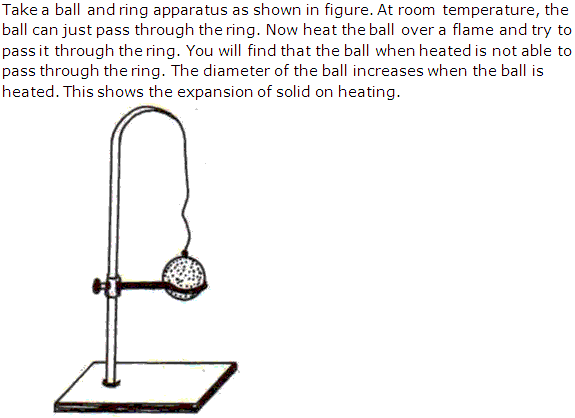
Question 13
The joins in metal pipes become loose in summer. Why?
Solution 13
The joints in metal pipes loosen in summers because the joints get more space to expand due to the heat in summers as compared to the pipes therefore the joints become loose in summers
Question 14
State three factors on which the increase in length of a rod depends, on heating.
Solution 14
The increase in length of a rod depends on the following factors
(a). material of the rod
(b). Original length of the rod
(c). Rise in temperature
(a). material of the rod
(b). Original length of the rod
(c). Rise in temperature
Question 15
'The coefficient of linear expansion for a metal is 0.000016 per 0C'. Explain the meaning of the statement.
Solution 15
The given statement states that the change in length of the metal will be 0.000016 m when its temperature changes by 10C.
Question 16
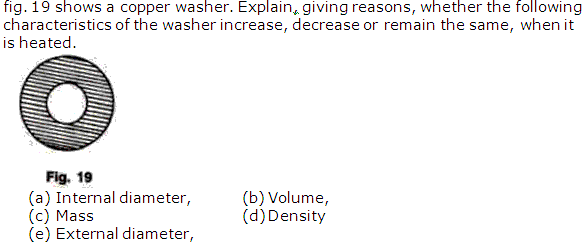
Solution 16
On heating the copper washer
(a). Its internal diameter will increase as the copper washer expands outwards
(b). Volume will increase as the size of the metal expands on heating
(c). Mass will remain the same as the mass does not change with change in temperature
(d). Density will decrease as the volume of the washer increases on heating and density is inversely proportional to volume
(e). External diameter will increase because the copper washer expands outwards
(a). Its internal diameter will increase as the copper washer expands outwards
(b). Volume will increase as the size of the metal expands on heating
(c). Mass will remain the same as the mass does not change with change in temperature
(d). Density will decrease as the volume of the washer increases on heating and density is inversely proportional to volume
(e). External diameter will increase because the copper washer expands outwards
Question 17
Show by an experiment that the real expansion of a liquid is equal to the sum of its apparent expansion of a liquid is equal to the sum of its apparent expansion and the volume expansion of the vessel containing the liquid.
Solution 17
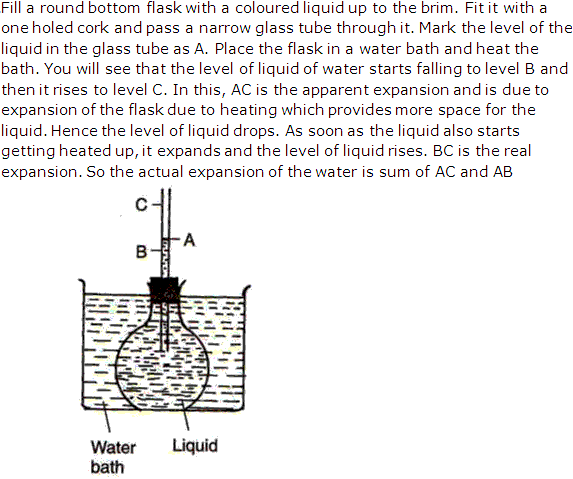
Question 18
At what temperature the density of water is maximum?
Solution 18
At 40C, water has the maximum density due to anomalous expansion.
Question 19
State the volume changes that you will observe when a given mass of water is heated from 00C to 100C. Sketch a temperature-volume graph to show the behavior.
Solution 19
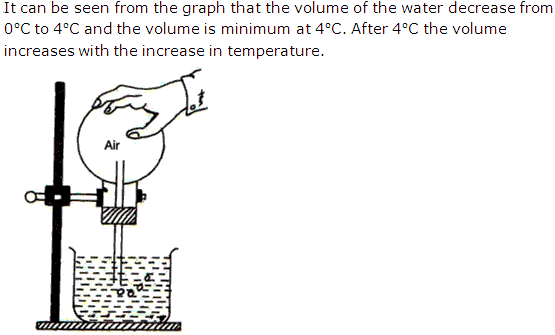

0 comments:
Post a Comment